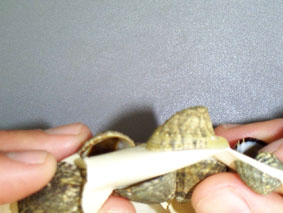
Turban snails and limpets are mollusks and belong to the Class Gastropoda. The classification of the specific species is outlined below:
Members of Phylum Mollusca are a diverse group characterized by the presence of a fleshy mantle that secretes a calcareous shell. Members of this phylum possess bilateral symmetry and a true coelom. Molluscs have true protostomal development. An important structure present in most molluscs, except for bivalves and aplacophora, is the radula. The radula is a complex rasping structure used for feeding. Molluscs typically have an open circulatory system (except for cephalopods) complete with heart, blood vessels, and respiratory pigments.
The turban snails and limpets belong to Class Gastropoda; One of seven classes assigned to the Phylum Mollusca. Gastropods are characterized by torsion, a process that results from twisting of the mantle cavity. The process of torsion takes place during the veliger stage of development. Most members of Gastropoda possess a muscular foot that is used for locomotion. Gastropods are recognized as having a true head with developed sensory organs.
Turban snails and limpets are members of the Subclass Prosobranchia. Prosobranchs are characterized by having their ctenida located anterior to their heart in the mantle cavity. Most prosobranchs have a well developed shell and in all but a few species the lateral nerve cord remains twisted after torsion. Typically sexes are separate, however, in some species there is hermaphroditism.
Turban snails and limpets are members of the Order Archaeogastropoda. All members of the Order Archaeogastropoda come from a single ancestral form. Members of Archaeogastropoda have rhipidoglossate radulae consisting of numerous rows of teeth. Archaeogastropoda is a large poorly defined group whose members possess one or two ctenida in their anterior mantle cavity.
Some limpets in southern California belong to the Superfamily Patellacea. Members of the Superfamily Patellacea are characterized as having a shell shape that resembles a small flattened saucer. Typically members of this superfamily have a shell that has a lustrous or iridescent inner layer.
Some limpets in southern California belong to the Familiy, Acmaeidae. Members of the Family Acmaeidae possess a single feather shaped gill and in the front of their shell a horseshoe shaped muscle scar.
Some limpets in southern California belong to the Genera, Lottiidae. Members of the Genus Lottiidae are a common group located on the west coast of the Pacific ocean.
Lottia digitalis. Lottia digitalis is an intertidal consumer of microscopic algae and diatoms. Frequently L. digitalis limits the amount of microscopic algae present on the rocks in the high intertidal zone. Lottia digitalis possess many digestive enzymes (laminarinase, K-carrageenase, agarase, and fucoidase) that facilitate the consumption of many types of algae. Lottia digitalis feeds at high tide when submerged. When exposed L. digitalis becomes less active and attaches itself to the rock below usually with the anterior portion of their shell pointed down. Lottia digitalis has the ability to secrete a mucus between its foot and shell that serves to secure it to the rock below and prevent desiccation and dislodgment. When exposed the heart and respiration rates also decrease. Respiration occurs through both a vascularized mantle fold and a single gill. When L. digitalis is submerged the mantle fold shrinks and primary respiration occurs through the expanded gill. However, when the limpet is exposed to air its gill shrinks and primary respiration takes place through the mantle fold. The largest specimens of L. digitalis are found typically higher up in the intertidal zone. Lottia digitalis occupies the same general niche as M. scabra and L. strigatella and therfore competitively compete for food resources. Shell repair is possible by the secretion of new material from the mantle. Spawning occurs in the winter, spring and summer. Lottia digitalis has a relatively short veliger stage. Typically the planktonic (veliger) larvae only remain in the water column from a few days to around a month. Recruitment of new individuals occurs typically from November to January. This short planktonic stage only allows for a limited dispersal of new individuals and recruitment is typically from the same or adjacent shore. The shells of some large individuals of this species accommodate the juvenile amphipod Hyale grandicornis. Some large adults may by as old as six years. Lottia digitalis is preyed upon by shorebirds and the crab Pachygraspsus crassipes.

Lottia strigatella. Lottia strigatella feeds primarily on microscopic algae and diatoms. Lottia strigatella is active when submerged. When exposed L. strigatella attaches itself to the substratum by secreting a mucus sheet between its foot and shell that prevents desiccation and dislodgment. When submerged the gill expands and respiration and heart rates increase. The ecology of L. strigatella is similar to that of L. digitalis. Reproduction occurs in the winter.
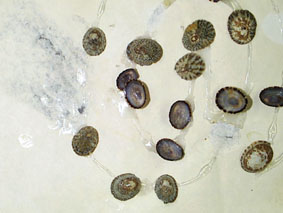
Lottia limatula. Lottia limatula feeds on both microscopic and macroscopic algae. Lottia limatula is commonly associated with sheets of coralline red algae. Lottia limatula is found near L. pelta in the lower intertidal with L. limatula occupying the higher portion of the zone. However, the species differ in the types of algae they consume. Lottia limatula prefers encrusted algae whereas L. pelta prefers erect species. Grazing occurs at high tide. Lottia limatula remains sessile when the tide is out. Respiration is similar to that of L. digitalis. Reproduction occurs in the winter. Spawning of olive-green eggs occurs in January, February, April, and October. Recruitment occurs shortly thereafter. Lottia limatula is preyed upon by the sea star Pisaster ochraceus and demonstrates an avoidance response to their presence. The shore crab P. crassipes is also a predator.
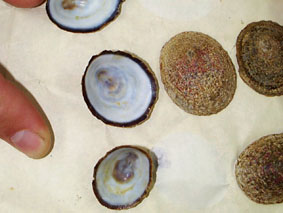
Lottia pelta. Lottia pelta feeds primarily on macroscopic erect algae. Lottia pelta i s associated with the algae, Egregia menziesii, Laminaria farlowii, and Pelvetia compressa. Some small individuals that are associated with the stipes and holdfasts of Egregia menziesii have a characteristic solid black color. Lottia pelta is common from the low to midintertidal. The largest individuals of this species are found lower on the shore farthest from effect of wave action. When the tide drops L. pelta moves down shore away from exposure. Lottia pelta is preyed upon by the sea star P. ochraceus.

Lottia digitalis (Rathke 1833) Common name- Fingered limpet. Lottia digitalis has a shell with an apex that is anterior. The anterior slope of the shell is concave and the posterior portion of the shell is convex. L. digitalis typically has strong ribbing on the posterior region. The shells of L. digitalis are colored brownish green to greenish black and frequently appear eroded with white spots. Shell lengths run from 1.5 to 3.5 cm in length. The side of the foot on L digitalis is white. They are common in the high rocky intertidal zone and are typically found on vertical or overhanging rock faces and infrequently in tidepools. Occasionally L. digitalis is found living on the goose-neck barnacle Pollicipes polymerus. Lottia digitalis sometimes found in aggregate groups of up to 44 individuals. Lottia digitalis feed on microscopic algae and diatoms during high tide. The Fingered limpet is found from the Aleutian Islands, Alaska to southern Baja California. Originally because of shell morphology and exclusive intertidal habitat L. digitalis was placed in the Genus Collisella. However, L. digitalis is now recognized as belonging to Genus Lottia because of ecological, radular and shell differences.
Lottia strigatella (Carpenter 1864) Common name- Checkered limpet. Lottia strigatella has a shell with an apex that anterior. The profile of the shell of L. strigatella is low and is recognized as having low radial ribs. Some individuals have an eroded appearance. Often the exterior is pitted by the fungus Didymella conchae. The color of the exterior of the shell is typically dull gray in appearance. The interior of the shell is white to blue with a dark border. The side of the foot of L. strigatella is white. Shells are typically 1.5 to 2.2 cm in length. Lottia strigatella are common in the midintertidal on protected horizontal and sloped surfaces. Lottia strigatella eat microscopic algae and diatoms. Lottia strigatella is common from Vancouver Island, British Colombia to Cape San Lucas, Baja California. Lottia strigatella are sometimes confused with L. digitalis and have been in the past refereed to as Lottia paradigitalis (Fritehram 1960). Originally because of shell morphology and exclusive intertidal habitat L. strigatella was placed in the Genus Collisella. However, L. strigatella i s now recognized as belonging to Genus Lottia because of ecological, radular and shell differences.
Lottia limatula (Carpenter 1864) Common name- File limpet. Lottia limatula has a shell with a non-centered apex and low slung profile. The outer surface of the shell has strong radial ribs with a serrate margin. Often the ribs are spiny and beaded giving it a rough texture. The shell is also often eroded and appears checkered white. The color of the shell is yellowish to brownish. Shells are typically 2.5 to 5.4 cm in length. The side of the foot of L. limatula is black and has parallel black lines with a white bottom. L. limatula is found in the mid to low intertidal zones. Lottia limatula feeds on several species of both macroscopic and microscopic algae. The file limpet is common from Newport, Oregon to southern Baja California. In bays there is a recognized sub-species Lottia limatula moerchii (Dall 1878). Lottia limatula originally because of shell morphology and exclusive intertidal habitat L. limatula was placed in the Genus Collisella. However, L. limatula is now recognized as belonging to Genus Lottia because of ecological, radular and shell differences.
Lottia pelta (Rathke 1833) Common name- Shield limpet. Lottia pelta has a shell with an apex that is near the center. The profile of L. pelta is very tall, Usually the height of the apex is greater than one third its length. Ribbing is sometimes present. The shell color is typically green to black and often it is eroded. Shells are typically 2.5 to 5.4 cm long. The side of the foot of L. pelta is white. Lottia pelta is common in the mid to low intertidal zones. Lottia pelta are often associated with the brown alga species: Egregia menziesii, Pelvetia compressa, and Laminaria farlowii. The Shield limpet is common from Aleutian Islands, Alaska to Rosario Bay, northern Baja California. Originally because of shell morphology and exclusive intertidal habitat L. pelta was placed in the Genus Collisella. However, L. pelta is now recognized as belonging to Genus Lottia because of ecological, radular and shell differences.
Lottia gigantea (Sowerby 1834) Common name- Owl limpet. The owl limpets are characterized by having a large low shell profile with a short apex near the anterior end. Typically, the shells are eroded and have many worn down areas. The color of the shell is typically brown with eroded white spots. The foot of L. gigantea is white. Around the periphery of the foot of L. gigantea is a distinctive pallial gill system. This species uses cillilary currents to pass water over its gills when submerged. The owl limpet is common in the midintertidal on cliff faces exposed to wave action. Lottia gigantea appears to withstand desiccation and temperature changes well. The owl limpet occupies a home scar and expresses territorial behavior. Females of this species can clear an area of 1000 square cm to let algae grow. Owl limpets eat these algae that grow in the open space around their home scar.
Limpets belonging to the Family Nacellidae are often confused with members of Family Acmaeidae because of the similar niche they occupy and similar morphology. Members of this family are recognized by the presence of dark spots on the sides of their head and bodies and shell morphology.
Members of Genus Maclintockia are recognized by their well scalloped shells and the presence of dark spots on the sides of their feet and body.
Maclintockia scabra (Gould 1846) Common name- Rough limpet. The rough limpet has a shell with strong radiating ribs and a scalloped margin. the shell of the rough limpet has a low slung apex that is typically one third the way down from the posterior end. The shell height is typically one fourth that of the length. The exterior shell color of the rough limpet is greenish to brownish. Maclintockia scabra is common on horizontal or sloping surfaces from the high intertidal to the splash zone. Some individuals of this species occupy a home scar. When high tide occur M. scabra leave their home scar to graze on microscopic algae and diatoms. When the tides begin to turn many return to their home scars. Macklintockia scabra compete with L. digitalis for food. However, M. scabra is more resilient to temperature changes and desiccation than L. digitalis. Macklintockia scabra is preyed upon by Pisaster ochraceus. The rough limpet was once placed in the Family Acmaeidae under the Genus Collisella. Now the species is recognized as Genus Macklintockia.
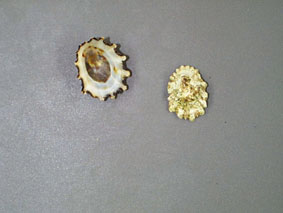
Limpets belonging the Superfamily Fissurellacea are recognizes having a flattened oval shell with an apical excurrent siphon.
Members of the Family Fissurellidae are distinguished by the presence of an apical hole and the shape of the callus margin on the inside of the shell.
Members of the Genus Fissurella can be distinguished by their central apex and hole.
Fissurella volocano (Reeve 1849) Common name- Volcano limpet. The volcano limpet has a distinctive hole in the apex of its shell. this hole is used as an excurrent siphon. The color of the shell is red with brown rays. Volcano limpets have a red striped mantle with a yellow foot. Fissurella volcano is found in the low intertidal under coraline encrusted rocks. Fissurella volcano uses coraline algae for food. Fissurella volcano i s preyed upon by Pisaster ochraceus.
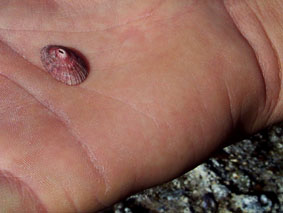
1a Shell has apical excurrent siphon, color red to pink ...Fissurella volcano
1b Shell has no apical excurrent siphon, color is never pink ...2
2a Shell surface well scalloped, dark spots on side of foot and head........Macklintockia scabra
2b No scallops on shell surface no dark spots on side of foot and head ..........3.
3a Side of foot has parallel lines, foot is dark color with white bottom, low apex.......Lottia limatula
3b Side of foot has no parallel lines.............4
4a Shell apex is greater than one third its length, side of foot white ...Lottia pelta
4b Shell apex is less than one third its length............... 5
5a Shell apex is low, side of foot has pallial gills often greater than 5.5 cm length .......Lottia gigantea
5b No pallial gills on foot, length less than 5.5 cm .............3
6a Shell slopes are convex, smooth texture, not generally bigger than 1.5 cm length..... Lottia strigatella
6b Anterior shell slope concave, posterior convex, rough texture.......Lottia digitalis